3~4세까지 유아들의 성장 발육, Growth and development of 3~4 year old preschoolers
3~4세까지 유아들의 성장
표 3-30. 3세 된 한국 유아들의 체중과 신장의 백분위수
|
백분위 수
성별 |
3 | 10 | 25 | 50 | 75 | 90 | 97 | |
| 남아 | 체중(kg) | 10.30 | 10.30 | 12.20 | 13.20 | 14.12 | 15.10 | 16.30 |
| 남아신장(cm) | 81.5 | 81.5 | 89.0 | 92.0 | 95.1 | 98.0 | 101.5 | |
| 여아 | 체중(kg) | 9.60 | 9.60 | 12.00 | 12.90 | 14.00 | 14.90 | 15.51 |
| 여아신장(cm) | 78.0 | 78.0 | 87.5 | 90.8 | 93.6 | 96.5 | 98.8 |
표 3-31. 3년 6개월 된 한국 유아들의 체중과 신장의 백부위수
|
백분위 수
성별 |
3 | 10 | 25 | 50 | 75 | 90 | 97 | |
| 남아 | 체중(kg) | 10.50 | 11.80 | 12.80 | 14.00 | 15.00 | 16.23 | 17.30 |
| 남아신장(cm) | 81.8 | 87.0 | 91.01 | 94.5 | 97.4 | 100.4 | 104.3 | |
| 여아 | 체중(kg) | 10.45 | 11.49 | 12.40 | 13.30 | 14.50 | 15.50 | 16.50 |
| 여아신장(cm) | 78.5 | 85.7 | 68.9 | 93.0 | 97.0 | 99.5 | 102.2 |
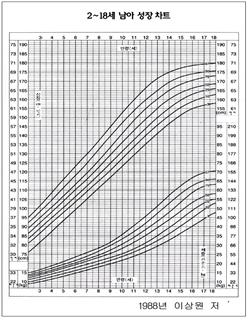
그림 3-166. 2~18세 한국 남아들의 체중과 신장의 성장차트와 백분위수.
Copyright ⓒ 2012 John Sangwon Lee, MD., FAAP

그림 3-167. 2~18세 한국 여아들의 체중과 신장의 성장차트와 백분위수.
Copyright ⓒ 2012 John Sangwon Lee, MD., FAAP
- 유아의 체중과 신장을 잰다.
- 그 잰 체중 치와 신장 치를 성장차트 체중·신장 백분위선에 그려 넣는다.
- 체중과 신장이 성장차트 체중·신장 백분위선 상 어디에 있는지 알아본다.
- 성장차트 체중·신장 백분위선을 따라 이전과 같이 체중과 신장이 계속 증가하면서 정상적으로 자라나 알아본다.
- 이 시기의 대부분의 유아들의 체중과 신장의 성장 속도가 정상적으로 느리고 그에 따라 음식물을 시원치 않게 섭취하는 유아들도 많다.
- 그러나 어디서 그렇게 힘이 나는지 의심할 정도로 힘이 세고 상당히 활동적이다.
- 위에서 설명한 것같이, 이 시기의 대부분의 유아들의 체중과 신장의 성장 속도가 정상적으로 상당히 느리다.
- 체중이 서서히 조금씩 느는 것이 보통이다.
- 아무 병이 없이 건강하게 잘 성장 발육하면 6~12개월마다 정기 건강검진을 받는다.
- 정기 건강검진을 받을 때마다 체중과 신장을 재고 잰 체중 치와 신장 치를 성장차트 백분위선에 그릴 때 체중과 신장이 성장 차트 체중·신장 백분위선을 따라 거의 전과 같이 계속 자라는지 확인한다.

사진 3-168. 3세경 소아청소년과에서 정기 건강검진을 받는다. 체중도 재고 신장도 잰다. 정상적으로 성장 발육하나 알아본다.
Copyright ⓒ 2012 John Sangwon Lee, MD., FAAP
| 소아청소년 예측 체중 신장주기와 소아청소년 예측 체중 신장 계산공식 |
소아청소년 예측 체중 신장주기와 소아청소년 예측 체중 신장 계산공식 참조
| 3~4세까지 유아들의 발육 |
1. 3~4세까지 유아들의 신체 발육
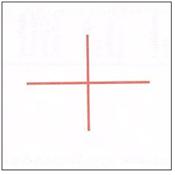
그림 3-169. 3세에서 4년 6개월 정도 되면 +(십자)를 보고 그릴 수 있다.
Copyright ⓒ 2012 John Sangwon Lee, MD., FAAP
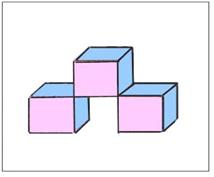
그림 3-170. 3세 정도 된 유아들은 장난감 정육면체 블록으로 다리를 만들 수 있다. 9개의 장난감 정육면체 블록을 차곡차곡 위아래로 쌓아서 탑을 만들 수 있다.
Copyright ⓒ 2012 John Sangwon Lee, MD., FAAP
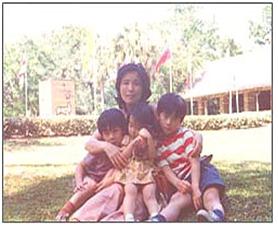
사진 3-171.신체적 접촉 사랑, 눈길 접촉 사랑, 집중적 관심적 사랑으로 조건 없이 진심으로 충분히 사랑해서 길러야 아이들은 최선을 다하고 최고가 되고 행복하게 자란다.
Copyright ⓒ 2012 John Sangwon Lee, MD., FAAP
- 대부분의 3세 유아들은 한 계단씩 번갈아 발로 디디며 계단을 올라가고 내려갈 수 있다.
- 맨 아래 계단에서 바닥으로 뛰어내릴 수 있고 한 발로 잠시 동안 설 수 있다.
- 자전거의 발판을 밟으면서 세발자전거를 탈 수 있다.
2. 3~4세까지 유아들의 손 발육
- 3세 유아들의 대부분은 자신이 입은 옷의 단추를 빼고 옷을 벗을 수 있다.
- 장난감 정육면체 블록 세 개로 다리 형태를 만들 수 있고 8~9개를 차곡차곡 위로 아래로 포개어 쌓아 탑 형태를 쌓을 수 있다.
- 3~4세 유아들의 대부분은 자기가 그린 그림을 보고 무엇을 그렸다고 말할 수 있고 동그라미나 열십자를 보고 그릴 수 있다.

사진 3-172. 18개월 된 유아가 그린 수직선과 그 외 그림.
Copyright ⓒ 2012 John Sangwon Lee, MD., FAAP
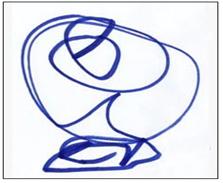
그림 3-173. 23개월 유아가 그린 원과 그림.
Copyright ⓒ 2012 John Sangwon Lee, MD., FAAP
3. 3~4세까지 유아들의 언어 발육
- 거의 천개 정도 단어들을 사용해서 말할 수 있다.
- ‘공들’, 또는 ‘개들’ 등 복수어를 써서 말할 수 있다.
- 남녀 이성의 차이를 어느 정도 알고 구별할 수 있다.
- 그림책에 있는 그림을 보고 그림대로 몸짓 말로 흉내 낼 수 있다.
- ‘위’ 또는 ‘아래’ 등의 전치사의 의미를 어느 정도 알 수 있다.
- 자기 성과 이름을 알 수 있다.
- 간단한 질의응답을 할 수 있다.
4. 3~4세까지 유아들의 사회성 발육
- 3세 유아들의 대부분은 방문을 열 수 있고,
- 변소에 가고 싶으면 간다고 말할 수 있고,
- 자기 혼자 음식물을 숟가락으로 먹을 수 있고,
- 신발을 신을 수 있다.
- 몇 개 정도 음악의 리듬을 알고 리듬에 따라 간단한 노래를 부를 수 있다.
- 또래들이나 친구들과 함께 놀 때 차례를 지키면서 놀 수 있다.
- p.00 “생후 1개월~6세의 영유아들의 발육 이정표”참조
| 3~4세까지 유아들의 영양 |
- 부모나 집안 식구들이 먹는 균형 잡힌 밥상 음식물을 하루에 세 번 주식으로 준다.
- 주식과 주식 사이에 간식을 2번 정도 준다.
- 의사의 처방 없이 비타민제나 철분제를 따로 줄 필요는 없다.
| 3~4세까지 유아들의 양호 |
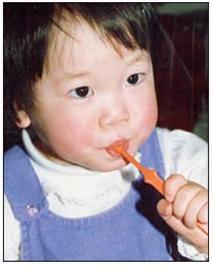
사진 3-174. 올바르게 칫솔질을 하는 법을 가르쳐 준다. 적어도 하루 세 번 이를 닦도록 한다. Copyright ⓒ 2012 John Sangwon Lee, MD., FAAP
- 주로 샘물이나 생수를 마실 때 생수에 치아 건강에 필요한 불소의 농도가 충분히 들어있나 알아봐야 한다.
- 식수로 마시는 샘물이나 생수에 불소가 충분히 들어있지 않으면 치과 의사나 소아청소년과 의사의 처방에 따라 불소제로 충치를 예방 해 일생동안 건강한 이를 갖도록 한다.
- 적어도 만 3세부터 연간 2회 치과 정기 치아검진을 받고 필요에 따라 적절한 치아 치료도 받는다.
- 특히 과자나 사탕 등 당질 성분 음식물을 먹은 후, 또는 식사 후 올바르게 칫솔질하는 법을 가르친다.
- 익사, 추락, 질식, 화상, 독극물 중독, 약물 중독, 화학물질 중독, 교통사고 등 안전사고가 생기지 않게 특히 조심하고 예방한다.
- 승용차를 타고 유아 자녀와 어디 갈 때 그 유아 자녀의 나이와 체중에 적절한 승용차 안전의자에 앉히고 운전해야 한다. [부모도 반의사가 되어야 한다-소아가정간호백과]-제 2권 소아청소년 질병과 안전사고 예방- 안전사고 예방참조
- 3세가 될 때쯤 정기 건강검진을 한다.
- 그때 권장 예방접종스케줄에 따라 감염병 예방접종을 다 해준다.
- 필요에 따라 투베르쿨린 결핵 피부 반응 검사를 해서 결핵균에 감염되었나 알아보고
- 빈혈이나 납중독에 걸렸나 알아보기 위해 혈액검사를 한다.
- 소변검사를 해서 당뇨병, 요로 감염, 혈뇨, 단백뇨 등이 있나 알아볼 수 있다.
- 시력검사와 청력검사는 적어도 1년에 1회 정도 소아청소년과에서 한다.
- [부모도 반의사가 되어야 한다-소아가정간호 백과]-제 19권 소아청소년 안과 질환-시력검사 참조.
- 이 시기의 대부분의 유아들은 1일 평균 1~3시간 동안 낮잠을 자고,
- 밤에는 9~10시간 동안 잠잔다.
- 자다가 무서운 꿈을 꿀 수 있다.
- 또 꿈꾸다가 놀래서 깰 수 있고 잠꼬대 할 수 있다.
- 이 다음 정기 건강검진은 1년에 1회, 또는 매 2년마다 1회 받을 수 있다.
- 정기 건강검진을 얼마나 자주, 검진을 받을 때 신체 각계통의 어느 기관을 어떻게 진찰 받고 어떤 임상 검사를 어떻게 해야 하는지는 그 자녀의 전반적인 건강 상태에 따라 부모의 의향과 단골 소아청소년과 전문의가 그때그때 결정한다.
- 법에 따라 헬멧을 쓰지 않고 자전거를 탈 수 없다는 것을 교육시킨다.
- 익사사고, 교통사고 등 안전사고가 나지 않게 특히 예방해야 한다.
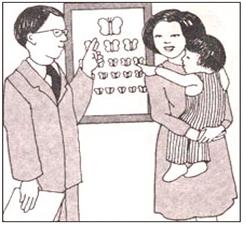
그림 3-175. 이런 시력 검사표로 3세경부터 정기적 시력 검사를 통상적으로 소아청소년과에서 한다. Copyright ⓒ 2012 John Sangwon Lee, MD., FAAP

사진 3-176. 시력에 이상이 있는 것 같으면 시력 검사를 필요에 따라 수시로 할 수 있다.
Copyright ⓒ 2012 John Sangwon Lee, MD., FAAP
| 3~4세까지 유아들의 장난감 |
장난감 참조
| 자녀 사랑 |
자녀 사랑 참조
|
다음은 “32개월인데 아직 말을 못하는 우리아이 말이 늦은 아이”에 관한 인터넷 소아청소년 건강상담 질의응답의 예 입니다. |
Q&A. 32개월인데 아직 말을 못하는 우리아이 말이 늦은 아이
Q.
- 저의 아이는 지금 33개월 된 남자아이입니다.
- 지금 우리아이가 제대로 말할 수 있는 단어는 몇 개 되지 않습니다. 그냥 단어만 따로 애기하는 정도 이지요. 예를 들자면 추워, 엄마 아빠, 껌 이 정도에요. 그렇다고 말귀를 못 알아듣는 것은 아니구요. 어른들 말은 다 알아듣고 행동한답니다. 위로 지금10살인 누나가 있습니다.
- 위의 누나도 말이 꽤 늦은 편이었구요. 놀이방을 다니고서야 말이 트였다고 하나요.
- 애들 아빠도 말수가 많은 편이 아니고 또 언어력이 좀 떨어진다고 해야 할까요. 사용하는 어휘수가 적은 편입니다. 아유 그렇다고 저의 애기아빠가 모자라는 사람은 아니구요. 같은 의사입니다.
- 제 생각에는 아빠도 누나도 다 말이 늦었다고 하니 별로 걱정을 하지 않고 있었는데 요즘 들어서 말을 가르킬려구 해도 제대로 따라하지를 못해서 겁이 납니다.
- 귀를 쥐라고 발음하고 신난다고 하면 그냥 시으으르다 하고 말고 해버리니 귀에 이상이 있는 것도 아닌 것 같고 발음을 제대로 못하니 답답합니다.
- 누나를 한동안 발음이 안돼서 계속 나노 라고 했었는데 얼마 전에야 고쳤읍니다. 듣는 것은 잘하는데 말하는 것이 굉장히 힘든가 봅니다. 몇 번 따라하다가 말아버립니다.
- 또 요즘은 자기의사를 표현할려구 노력하는데 잘 안되니 답답한가봅니다.
- 우리아이에게 무슨 문제가 있는 건가요. 이제껏 집에서 저하고만 있어서 그런가 싶어서 이번 달부터는 놀이방도 보낸답니다. 시간이 지나면 되는건가요. 아님 무슨 언어장애라도 있는 건지요.
- 말이 너무 길었습니다. 소아청소년과학책을 찾아도 상세히 나오지 않아서 상담드립니다.
A.
- 동형맘께
- 안녕하세요. 질문해 주셔서 감사합니다.
- 좋은 질문입니다. 자녀의 나이, 성별, 과거 병력, 가족 병력, 진찰소견, 임상검사 등의 정보를 많이 알수록 답변을 드리는데 도움이 됩니다. 주신 정보를 토대로 답변 드리겠습니다.
- 33개월 유아들의 75%는 복수와 단수를 구별해서 말을 할 수 있읍니다.
- 50%는 성이 무언지 이름이 무언지 말할 수 있습니다.
- 25% 정도는 차다 뜨겁다, 피곤하다 배가 고프다는 말을 할 수 있습니다.
- 25% 정도는 3개 정도 전치사를 써서 말 할 수 있습니다.
- 거의 100%가 두 단어를 사용해서 말할 수 있습니다.
- 적어도 한 인격 대명사를 쓰지도 못하거나 두 단어를 같이 붙여 쓰지 못하면 언어에 어떤 이상이 있다고 진단할 수 있습니다.
- 저도 걱정이 됩니다.
- 저한테 자녀를 데리고 오신다면 성장 발육이 정상인가 전체적으로 평가하겠습니다.
- 특히 중이가 정상인지 진찰해서 알아보고 청력검사를 하겠습니다.
- 한쪽 귀로 잘 듣고 다른 쪽 귀로 잘 듣지 못하거나 귀가 조금 먹은 경우도 잘 듣는 유아같이 취급받을 수 있습니다.
- 그런 유아들 중 어떤 유아들은 말할 때 남의 입을 쳐다보고 말을 알아들을 수 있습니다.
- 물론 말 발육이 늦어지게 됩니다.
- 5세 이전 많은 유아들이 정상적으로 자음을 조화 있게 잘 쓰지 못할 수 있습니다.
- 그러면 말이 늦어질 수 있지요.
- 대부분 경우 말하는 것이 지연되는 원인은 청력문제, 발육지연, 말을 잘 할 수 있게 가르치지 않는 것입니다.
- 때문에 청력검사를 꼭 해야 합니다.
- 영유아들 청력검사를 많이 해본 경험이 있는 언어 청력 검사실에서 청력검사를 받아야 하는 것도 중요합니다.
- 그리고 지능검사도 하고 때로는 소아신경과 전문의의 진단을 받아야 할 때도 있습니다.
- 모든 진단결과가 정상이면 언어교정 치료를 해 주시기 바랍니다.
- 참고로 소아자폐증 등 어떤 병이 있는 아이의 언어발육이 늦어질 수 있습니다.
- 더 자세한 것은 자녀의 소아청소년과 의사의 진찰 진단을 받으시고 이 문제에 대해서 상담하시기 바랍니다.
- 해당 연령 성장 발육,생후 1개월~6세 아이들의 발육 이정표. 부모도 반의사가 되어야 한다–소아가정간호 백과–제 18권 소아청소년 이비인후 질환–난청을 참조하시기 바랍니다.
- 이런 경우에는 발육지연을 의심해본다 참조
- 질문이 더 있으시면 다시 연락 주시기 바랍니다. 감사합니다. 이상원 드림
Growth and development of 3-4-year-old preschoolers
Growth of preschoolers from 3 to 4 years of age
Table 3-30. Percentiles of weight and height for 3-year-old Korean preschoolers percentile
표 3-30. 3세 된 한국 유아들의 체중과 신장의 백분위수
|
percentile
Gender |
3 | 10 | 25 | 50 | 75 | 90 | 97 | |
| boy | weight(kg) | 10.30 | 10.30 | 12.20 | 13.20 | 14.12 | 15.10 | 16.30 |
| height(cm) | 81.5 | 81.5 | 89.0 | 92.0 | 95.1 | 98.0 | 101.5 | |
| girl | weight(kg) | 9.60 | 9.60 | 12.00 | 12.90 | 14.00 | 14.90 | 15.51 |
| height(cm) | 78.0 | 78.0 | 87.5 | 90.8 | 93.6 | 96.5 | 98.8 |
Table 3-31. Percentage of weight and height in Korean preschoolers aged 3 years and 6 months percentile 표 3-31. 3년 6개월 된 한국 유아들의 체중과 신장의 백부위수
|
percentile
Gender |
3 | 10 | 25 | 50 | 75 | 90 | 97 | |
| boy | weight(kg) | 10.50 | 11.80 | 12.80 | 14.00 | 15.00 | 16.23 | 17.30 |
| height(cm) | 81.8 | 87.0 | 91.01 | 94.5 | 97.4 | 100.4 | 104.3 | |
| girl | weight(kg) | 10.45 | 11.49 | 12.40 | 13.30 | 14.50 | 15.50 | 16.50 |
| height(cm) | 78.5 | 85.7 | 68.9 | 93.0 | 97.0 | 99.5 | 102.2 |

Figure 3-166. Growth charts and percentiles of weight and height for Korean boys aged 2 to 18 years old. Copyright ⓒ 2012 John Sangwon Lee, MD., FAAP

Figure 3-167. Growth charts and percentiles of weight and height for Korean girls aged 2 to 18 years. Copyright ⓒ 2012 John Sangwon Lee, MD., FAAP
• Measure the infant’s weight and height.
• Draw the measured weight and height values on the growth chart weight and height percentiles.
• Find out where their weight and height are on the weight and height percentiles of the growth chart.
• Growth chart follows the weight and height percentiles to see if your weight and height continue to increase as before and grow normally.
• Most preschoolers at this age grow normally slowly in weight and height, and many infants eat poorly as a result.
• But they are strong enough to question where they get so much energy and are quite active.
• As noted above, most preschoolers at this age are normally quite slow in weight and height growth.
• It is normal to gain weight slowly and gradually.
• If you grow and develop in good health without any disease, preschoolers should receive regular health checkups every 6 to 12 months.
• Every time you have a regular health check-up, measure your weight and height, and when you draw the measured weight and height values on the growth chart percentile line, check that preschoolers’ weight and height continue to grow almost as before along the growth chart weight/height percentile line.

Picture 3-168. 3 Years old, undergo a regular health checkup at the Pediatric clinic. Measure preschoolers’ weight and measure their height. Find out if it grows and develops normally. Copyright ⓒ 2012 John Sangwon Lee, MD., FAAP
Predicted weight and height for children and adolescents
predicted weight and height calculation formula
Refer to the weight and height calculation formula for children and adolescents predicted weight and height cycle and predicted weight for children and adolescents
Development of preschoolers from 3 to 4 years of age
1. Physical development of preschoolers from 3 to 4 years old

Figure 3-169. From the age of 3 to 4 years and 6 months, you can see the + (cross) and draw. Copyright ⓒ 2012 John Sangwon Lee, MD., FAAP

Figure 3-170. 3 years old children can build a bridge out of toy cubes. He can build a tower by stacking 9 toy cube blocks one by one. Copyright ⓒ 2012 John Sangwon Lee, MD., FAAP

Picture 3-171. Children do their best and grow up to be the best and grow up happily when they are brought up with unconditional, sincere, and sufficient love through physical contact love, eye contact love, and intensive focus attention love, and care. Copyright ⓒ 2012 John Sangwon Lee, MD., FAAP
• Most 3-year-olds can go up and downstairs by stepping alternately.
• Able to jump to the floor from the bottom stairs and stand for a while on one leg.
• He can ride a tricycle while stepping on the pedals of the bicycle.
2. Hand development of preschoolers up to 3-4 years old
• Most 3-year-olds can unbutton their clothes and take them off.
• They can make a bridge with three toy cube blocks, and stack 8-9 pieces one by one to form a tower.
• Most of the 3 to 4-year-olds can see what they have drawn and can draw by looking at a circle or a cross.

Picture 3-172. Vertical lines and other drawings were drawn by an 18-month-old toddler. Copyright ⓒ 2012 John Sangwon Lee, MD., FAAP

Figure 3-173. Circles and drawings were drawn by a 23-month-old toddler. Copyright ⓒ 2012 John Sangwon Lee, MD., FAAP
3. Language development of preschoolers from 3 to 4 years old
• Can speak using almost a thousand words.
• Speak with plural words such as ‘balls’ or ‘dogs’.
• Can recognize and distinguish differences between men and women to some extent.
• Look at the pictures in the picture book and imitate the pictures with body language.
• Can understand to some extent the meaning of prepositions such as ‘above’ or ‘below’.
• Know your first and last name.
• Able to answer simple questions.
4. Social development of preschoolers up to 3-4 years old
• Most 3-year-olds can open a door,
• If he wants to go to the toilet, he can say he want to go,
• can eat food with a spoon on its own;
• Can wear shoes.
• Know the rhythm of some music and be able to sing simple songs according to the rhythm.
• You can take turns playing with your peers or friends.
• See “Milestones in the development of infants and toddlers aged 1 month to 6 years” Nutrition for infants from 3 to 4 years old
• Give a parent or family member a well-balanced meal three times a day as a staple food.
• Give 2 snacks between main meals.
• There is no need to give vitamins or iron supplements without a doctor’s prescription.
Good care and parentings for preschoolers up to 3-4 years old

Picture 3-174. Teach them how to brush their teeth properly. Brush their teeth at least three times a day. Copyright ⓒ 2012 John Sangwon Lee, MD., FAAP
• When they drink spring or bottled water, you should check whether the mineral water contains enough fluoride for dental health.
• If the spring or bottled water they drink does not contain enough fluoride, use fluoride as prescribed by your dentist or pediatrician to prevent tooth decay and keep healthy teeth for life.
• Get regular dental checkups twice a year from the age of at least 3 years old and receive appropriate dental treatment as needed.
• Teach them how to properly brush their teeth after eating or eating sugary foods, especially sweets and candies.
• Be especially careful and prevent accidents such as drowning, falling, suffocation, burns, poison poisoning, drug poisoning, chemical poisoning, and traffic accidents.
• When traveling with a preschooler in a car, be sure to sit in a car seat suitable for the child’s age and weight and drive. www.drleepediatrics.com – Volume 2 Children and Adolescent Diseases and Safety Accident Prevention – Refer to Safety Accident Prevention
• Get regular health checkups around the age of three.
• At that time, all vaccinations against infectious diseases are performed according to the recommended vaccination schedule.
• If necessary, take a tuberculin tuberculosis skin test to determine if you are infected with Mycobacterium tuberculosis
• Do blood tests to see if you have anemia or lead poisoning.
• You can check for diabetes, urinary tract infection, hematuria, or proteinuria by doing a urine test.
• Vision and hearing tests are performed at least once a year in Pediatric clinic.
•www.drleepediatrics.com – See Volume 19 Children’s and Adolescent Eye Diseases – Eye Examination.
• Most preschoolers at this age nap an average of 1 to 3 hours per day,
• Sleep for 9 to 10 hours at night.
• You may have terrifying dreams while sleeping.
•They can wake up in a dream again and talk about sleep.
• You can receive this next regular health checkup once a year or once every two years.
• How often to have regular health check-ups, which organs in each body system, how to check and which clinical tests to perform depends on the child’s overall health, parents’ intentions and regular pediatricians decide
• Educate students that the law prohibits riding a bicycle without a helmet.
• Special precautions should be taken to prevent accidents such as drowning and traffic accidents.

Figure 3-175. With this eye exam table, regular eye exams are usually performed at the Pediatric clinic from around the age of 3 years old. Copyright ⓒ 2012 John Sangwon Lee, MD., FAAP

Picture 3-176. If you think there is something wrong with your eyesight, he can have an eye exam as often as necessary. Copyright ⓒ 2012 John Sangwon Lee, MD., FAAP
Toys for toddlers up to 3-4 years old toy
Reference child love see CHILD LOVE
The following is an example of a Q&A on health counseling for children and adolescents on the Internet about “my child who is 32 months old and cannot speak yet.”
Q&A. My child, who is 32 months old and still can’t speak
Q.
• My child is now a 33 month old boy.
• There are only a few words my child can speak properly now. It’s just a matter of saying the words separately. For example, it’s cold, mom and dad, chewing gum. That doesn’t mean I can’t hear you. Adults understand and act. Back to top I have an older sister who is now 10 years old.
• The older sister was also quite late. He said he didn’t start talking until he went to the playroom.
• It must be said that the fathers of the children are not very talkative and their language skills are a bit weak. There are few words used. Aww, that doesn’t mean my baby’s daddy is a hater. Same doctor.
• I think he wasn’t too worried because both his dad and his sister said he was late, but these days he’s afraid that he can’t follow properly even when he tries to teach him.
• Pronounce your ears to hold and if you say it’s exciting, you just say it’s boring and do it. It doesn’t seem like there’s anything wrong with your ears and it’s frustrating because you can’t pronounce it properly.
• I kept calling my sister nano because I couldn’t pronounce it for a while, but I just fixed it a while ago. Hearing is good, but speaking is very difficult. I followed it a few times and then quit.
• Also, these days, I’m trying to express my thoughts, but it’s frustrating because it doesn’t work.
• What’s wrong with my child? I wondered if it was because I was the only one at home so far, so from this month on, I also sent a playroom. Will it be over time? Or do you have some language problem?
• The speech was too long. I can’t find detailed information on pediatric and adolescent science books, so I’ll consult with you.
A.
• My brother-in-law
• Good morning. Thanks for asking.
• Good question. The more information you know about your child’s age, gender, past medical history, family history, examination findings, and clinical tests, the more helpful it is to give you an answer. We will respond based on the information you have provided.
• 75% of 33 month olds can speak plural and singular.
• 50% can say what their last name is and what their first name is.
• About 25% can say they are cold or hot, tired or hungry.
• About 25% can speak with 3 prepositions.
• Nearly 100% can speak using two words.
• If you can’t use at least one personal pronoun or put two words together, you can diagnose something wrong with your language.
• I’m worried too.
• If you bring a child to me, I will evaluate the growth and development as a whole.
• In particular, we will examine whether the middle ear is normal and do a hearing test.
• If you hear well with one ear and have poor hearing with the other, or even a little deaf, you can be treated like a good listener.
• Some of these infants can look and understand when speaking.
• Of course, horse development is delayed.
• Many children before the age of 5 may not be able to use consonants in harmony as they normally would.
• Then you may be late.
• In most cases, delays in speaking are caused by hearing problems, developmental delays, or not being taught to speak well.
• For this reason, you must have a hearing test.
• It is also important that young children have their hearing tested at a speech hearing laboratory that has experience with many hearing tests.
• We also do intelligence tests and sometimes you need to be diagnosed by a pediatric neurologist.
• If all diagnosis results are normal, please perform speech orthodontic treatment.
• For your reference, speech development may be delayed in children with certain diseases, such as childhood autism.
• For more information, see your child’s pediatrician and discuss this issue.
• Growth and development milestones for children aged 1 month to 6 years.www.drleepediatrics.com – Volume 18 Children and Adolescent Otolaryngology – Hearing Loss.
• In this case, I suspect growth retardation.
• If you have more questions, please feel free to contact us. Thank you. Lee Sang-won .
출처 및 참조문헌
- Nelson Textbook of Pediatrics 22ND Ed
- The Harriet Lane Handbook 22ND Ed
- Growth and development of the children
- www.drleepediatrics.com 제1권 소아청소년 응급 의료
- www.drleepediatrics.com 제2권 소아청소년 예방
- www.drleepediatrics.com 제3권 소아청소년 성장 발육 육아
- www.drleepediatrics.com 제4권 모유,모유수유, 이유
- www.drleepediatrics.com 제5권 인공영양, 우유, 이유식, 비타민, 미네랄, 단백질, 탄수화물, 지방
- www.drleepediatrics.com 제6권 신생아 성장 발육 육아 질병
- www.drleepediatrics.com제7권 소아청소년 감염병
- www.drleepediatrics.com제8권 소아청소년 호흡기 질환
- www.drleepediatrics.com제9권 소아청소년 소화기 질환
- www.drleepediatrics.com제10권. 소아청소년 신장 비뇨 생식기 질환
- www.drleepediatrics.com제11권. 소아청소년 심장 혈관계 질환
- www.drleepediatrics.com제12권. 소아청소년 신경 정신 질환, 행동 수면 문제
- www.drleepediatrics.com제13권. 소아청소년 혈액, 림프, 종양 질환
- www.drleepediatrics.com제14권. 소아청소년 내분비, 유전, 염색체, 대사, 희귀병
- www.drleepediatrics.com제15권. 소아청소년 알레르기, 자가 면역질환
- www.drleepediatrics.com제16권. 소아청소년 정형외과 질환
- www.drleepediatrics.com제17권. 소아청소년 피부 질환
- www.drleepediatrics.com제18권. 소아청소년 이비인후(귀 코 인두 후두) 질환
- www.drleepediatrics.com제19권. 소아청소년 안과 (눈)질환
- www.drleepediatrics.com 제20권 소아청소년 이 (치아)질환
- www.drleepediatrics.com 제21권 소아청소년 가정 학교 간호
- www.drleepediatrics.com 제22권 아들 딸 이렇게 사랑해 키우세요
- www.drleepediatrics.com 제23권 사춘기 아이들의 성장 발육 질병
- www.drleepediatrics.com 제24권 소아청소년 성교육
- www.drleepediatrics.com 제25권 임신, 분만, 출산, 신생아 돌보기
- Red book 29th-31st edition 2021
- Nelson Text Book of Pediatrics 19th- 21st Edition
- The Johns Hopkins Hospital, The Harriet Lane Handbook, 22nd edition
- 응급환자관리 정담미디어
-
소아가정간호백과–부모도 반의사가 되어야 한다, 이상원
-
Neonatal Resuscitation American heart Association
-
Neonatology Jeffrey J.Pomerance, C. Joan Richardson
-
Pediatric Resuscitation Pediatric Clinics of North America, Stephen M. Schexnayder, M.D.
-
Pediatric Critical Care, Pediatric Clinics of North America, James P. Orlowski, M.D.
-
Preparation for Birth. Beverly Savage and Dianna Smith
-
Infectious disease of children, Saul Krugman, Samuel L Katz, Ann A. Gershon, Catherine Wilfert
- 소아과학 대한교과서
- Growth and Development of Children, Eighth Edition, George H. Lowrey, Yearbook Medical Publishers
- Growth and Development of Children, Fifth Edition, E. H. Watson and G. H. Lowrey, Yearbook Medical Publishers
- Other